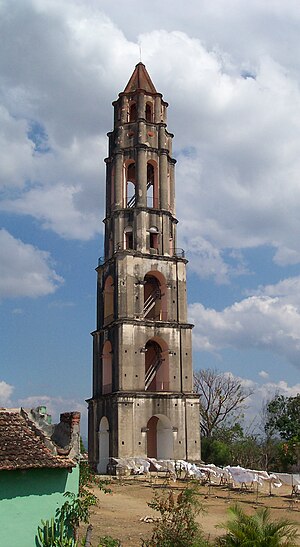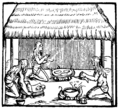Welcome to the Cuba Portal
Location of Cuba in the Caribbean
Cuba Republic of Cuba , is an island country , comprising the island of Cuba, Isla de la Juventud , archipelagos , 4,195 islands and cays surrounding the main island. Cuba is located where the northern Caribbean Sea , Gulf of Mexico , and Atlantic Ocean meet. Cuba is located east of the Yucatán Peninsula (Mexico), south of both Florida and the Bahamas , west of Hispaniola (Haiti /Dominican Republic ), and north of Jamaica and the Cayman Islands . Havana is the largest city and capital. Cuba is the third-most populous country in the Caribbean after Haiti and the Dominican Republic , with about 11 million inhabitants. It is the largest country in the Caribbean by area.
Cuba is a socialist state , in which the role of the Communist Party is enshrined in the Constitution . Cuba has an authoritarian government where political opposition is not permitted. Censorship is extensive and independent journalism is repressed; Reporters Without Borders has characterized Cuba as one of the worst countries for press freedom. Culturally, Cuba is considered part of Latin America. It is a multiethnic country whose people , culture and customs derive from diverse origins, including the Taíno Ciboney peoples, the long period of Spanish colonialism, the introduction of enslaved Africans and a close relationship with the Soviet Union during the Cold War. (Full article...
The following are images from various Cuba-related articles on Wikipedia.
Image 1 Defense of a train attacked by Cuban insurgents (from
History of Cuba )
Image 2 A
watercolor painting of Havana Bay,
c. 1639 (from
History of Cuba )
Image 3 The Bay of Pigs Memorial in
Miami , Florida (from
History of Cuba )
Image 4 Soldiers of
FAR (from
History of Cuba )
Image 5 The city walls of Havana, 1848 (from
History of Cuba )
Image 6 The fortress of
El Morro in Havana, built in 1589 (from
History of Cuba )
Image 7 The Casino Español, Matanzas (from
Culture of Cuba )
Image 9 Three generations of women (from
Culture of Cuba )
Image 10 Public transportation in Cuba during the "Special Period" (from
History of Cuba )
Image 11 President
Carlos Prío Socarrás (left), with US president
Harry S. Truman in Washington, D.C. in 1948 (from
History of Cuba )
Image 12 Taíno women preparing
cassava bread (from
History of Cuba )
Image 13 19th century view of Havana (from
History of Cuba )
Image 14 Rebel leaders engaged in extensive propaganda to get the U.S. to intervene, as shown in this cartoon in an American magazine.
Columbia (the American people) reaches out to help oppressed Cuba in 1897 while
Uncle Sam (the U.S. government) is blind to the crisis and will not use its powerful guns to help.
Judge magazine, 6 February 1897. (from
History of Cuba )
Image 15 Cuban victims of Spanish reconcentration policies (from
History of Cuba )
Image 16 The British Fleet Entering Havana, 21 August 1762 , a 1775 painting by
Dominic Serres (from
History of Cuba )
Image 17 States proposed in the
Spanish Draft Federal Constitution of 1873 , among which Cuba was included. (from
History of Cuba )
Image 18 Depiction of an engagement between Cuban rebels and Spanish Royalists during the
Ten Years' War (1868–78) (from
History of Cuba )
Image 19 Tobacco fields in Cuba, 1859 (from
History of Cuba )
Image 20 Capablanca playing chess with his father José María Capablanca in 1892 (from
Culture of Cuba )
Image 21 Cuban
PT-76 tank crew on routine security duties in Angola (from
History of Cuba )
Image 22 Banrarra Afro-Cuban dance troupe (from
Culture of Cuba )
Image 23 Russian
T-34 tank at Museo Giron, Cuba (from
History of Cuba )
Image 24 A monument to the Taíno chieftain Hatuey in
Baracoa , Cuba (from
History of Cuba )
Image 25 A 1736 colonial map by
Herman Moll of the West Indies and Mexico, together comprising "
New Spain ", with Cuba visible in the center. (from
History of Cuba )
Image 26 Fidel Castro 's
July 26 Movement rebels mounted on horses in 1959 (from
History of Cuba )
Image 27 Camilo Cienfuegos ,
Fidel Castro ,
Huber Matos , entering Havana on 8 January 1959 (from
History of Cuba )
Image 28 The wreckage of the
USS Maine , photographed in 1898 (from
History of Cuba )
(auto-generated)
... that José Ramón Balaguer
... that before his Major League Baseball career, Leo Posada cycling ?
... that after his movement's victory in the Cuban Revolution , television broadcasts showed Camilo Cienfuegos
... that after his release from a hospital for the criminally insane, Richard Dixon
... that Rudi Kappel Santiago de Cuba ?
... that Brooklyn Nine-Nine actress Melissa Fumero
Entries here consist of Good and Featured articles, which meet a core set of high editorial standards. Fidel Alejandro Castro Ruz KASS -trohLatin American Spanish: [fiˈðel aleˈxandɾo ˈkastɾo ˈrus] Cuba from 1959 to 2008, serving as the prime minister of Cuba from 1959 to 1976 and president from 1976 to 2008. Ideologically a Marxist–Leninist and Cuban nationalist , he also served as the first secretary of the Communist Party of Cuba from 1965 until 2011. Under his administration, Cuba became a one-party communist state ; industry and business were nationalized , and socialist reforms were implemented throughout society.
Born in
Birán , the son of a wealthy Spanish farmer, Castro adopted
leftist and
anti-imperialist ideas while studying law at the
University of Havana . After participating in rebellions against right-wing governments in the
Dominican Republic and
Colombia , he planned the overthrow of Cuban president
Fulgencio Batista , launching a failed
attack on the Moncada Barracks in 1953. After a year's imprisonment, Castro travelled to Mexico where he formed a revolutionary group, the
26th of July Movement , with his brother
Raúl Castro and
Ernesto "Che" Guevara . Returning to Cuba, Castro took a key role in the
Cuban Revolution by leading the Movement in a
guerrilla war against Batista's forces from the
Sierra Maestra . After Batista's overthrow in 1959, Castro assumed military and political power as Cuba's prime minister. The United States came to oppose Castro's government and unsuccessfully attempted to
remove him by assassination ,
economic embargo , and counter-revolution, including the
Bay of Pigs Invasion of 1961. Countering these threats, Castro aligned with the
Soviet Union and allowed the Soviets to place nuclear weapons in Cuba, resulting in the
Cuban Missile Crisis —a defining incident of the
Cold War —in 1962. (
Full article... )
List of recognized articles
Tower at Manaca Ignaza
Pre-Revolution Post-Revolution Cities
Cuba topics condensed
Sports persons
edit Boxing
Adolfo Horta , Featherweight Olympic boxerAriel Hernández , Middleweight Olympic boxerArmando Martínez , Light middle-weight Olympic boxerBenny Paret , boxerEliseo Castillo , boxerFélix Savón , Olympic gold medal winning boxerFlorentino Fernández , boxerGuillermo Rigondeaux Ortiz , amateur boxerJoel Casamayor , boxerJorge Rubio , Boxing trainer.José Napoles , boxerKid Charol , BoxerKid Chocolate , boxerKid Gavilan , boxerLorenzo Aragon Armenteros Olympic welterweight boxerLuis Manuel Rodriguez , boxerMario César Kindelán Mesa , Olympic gold medal winning boxerRaúl González , boxerRoberto Balado , Olympic Super Heavyweight boxerSugar Ramos , world champion boxerTeofilo Stevenson , amateur boxerYanqui Diaz , boxerYudel Johnson Cedeno Light-Welterweight Olympic BoxerAthletics
Alberto Juantorena , basketball, trackAliecer Urrutia , triple jumpAna Fidelia Quirot 800mDayron Robles , Hurdling athleteEmeterio González , javelin thrower.Hector Herrera , sprinterIoamnet Quintero , high jumperIván García , sprinterIván Pedroso , long jumpJavier Sotomayor , track and field record setterJoel Isasi , sprinterJoel Lamela , sprinterJorge Aguilera , sprinterLazaro Martínez , sprinterLuis Alberto Pérez-Rionda , sprinterOsleidys Menéndez , javelinRoberto Hernández (track athlete) Roberto Moya , discus throwVíctor Moya , high jumperYargelis Savigne , jumpYipsi Moreno , hammer throwerYoandri Betanzos , triple jumpYoel García , triple jumperYoel Hernández hurdlerYudelkis Fernández long jumper.Yunaika Crawford , hammer throwerYuniel Hernández , hurdlerOther
Adolfo Luque , Cincinnati RedsAlberto Delgado Pérez , soccerAlex Sánchez , Baseball Free AgentAriel Pestano , Cuban Baseball PlayerAriel Prieto , Oakland AthleticsAurelio Monteagudo , Kansas City AthleticsBarbaro Garbey , Detroit TigersBert Campaneris , Kansas City AthleticsBrayan Peña , Atlanta BravesJosé Raúl Capablanca , chess world champion, grandmaster considered "the Mozart of Chess"Cristóbal Torriente , Negro Leagues - Baseball Hall of Fame Danys Báez , Cleveland IndiansDiego Seguí , Kansas City AthleticsEli Marrero , New York MetsEsteban Bellán , first Latin American professional baseball player to play in the United StatesGermán Mesa , trainer for the Cuban national baseball teamHéctor Socorro , footballer Ibrahim Rojas , flatwater canoerJack Calvo , Washington SenatorsJosé Canseco , Oakland AthleticsJosé Cardenal , San Francisco GiantsJosé Contreras , Chicago White SoxJosé Méndez , Kansas City Monarchs - Baseball Hall of Fame José Tartabull , Kansas City AthleticsJuan Corzo , chessJuan Tuñas , former Cuban footballerKendry Morales Lázaro Bruzón , chess grandmasterLiván Hernández , Arizona Diamondbacks Luis Tiant , Cleveland IndiansMartín Dihigo , Negro Leagues - Baseball Hall of Fame Mike Cuellar , Cincinnati RedsMinnie Miñoso , Chicago White Sox - Baseball LegendOctavio “Cookie” Rojas , Cincinnati RedsOmar Linares , Pinar del Río Vegueros, Cuban national baseball team Orestes Destrade , New York YankeesOrlando Hernández , New York MetsOzzie Canseco , Oakland AthleticsPedro Ramos , Washington SenatorsPreston Gómez , Washington SenatorsRafael A. Lecuona , GymnastRafael Palmeiro , Baltimore OriolesRay Noble , New York GiantsRené Arocha , St. Louis CardinalsRené Monteagudo , Washington SenatorsRey Ángel Martínez , soccerRey Ordóñez , Baseball Free AgentRoberto "Bobby" Estalella , Washington SenatorsRodolfo Falcon , swimmerRolando Arrojo , Tampa Bay Devil RaysSandy Amorós , Brooklyn DodgersTomás Fernández , footballer in the 1938 world cupTony Fossas , Texas RangersTony González , Cincinnati RedsTony Oliva , Minnesota TwinsTony Pérez , Cincinnati RedsTony Taylor , Chicago CubsYanelis Yuliet Labrada Diaz , Olymipic silver medallist in TaekwondoYuniesky Betancourt , Seattle MarinersZoilo Versalles , baseball player and first Latin American major league MVP 1965
edit People and organizations
Democracy and human rights
Foreign relations
edit Films
Directors
Actors
Category puzzle Select [►] to view subcategories
Wikipedia's maxim is that anyone can edit . If you are interested in Cuba and have useful information that would form a new article or would enhance an existing article, please feel free to take part. Here are some tasks you can do to help with WikiProject Cuba
Task list
New article announcements Requests Ambrosio Cave , Calero Cave , Centella Cave , Cuba and the United Nations , Cuban Liberation Army , Cuevas de Punta del Este , Cura Cave , Patana Cave , Pluma Cave Stubs Dollar store (Cuba) Verify History of Cuba , Fulgencio Batista Update Nochebuena NPOV Armando Valladares , Delfín Fernández , History of Cuba Copyedit Armando Peraza , Bay of Pigs Invasion , Fabio Grobart , Julio Antonio Mella Cleanup Abelardo Colomé Ibarra , Antonio Maceo Grajales , Bay of Pigs Invasion , History of Cuba , List of Cubans , Máximo Gómez , War against the Bandits Style Fidel Castro Expand : Cuba–Soviet Union relations , Baseball in Cuba , Religion in Cuba , Havana's International Book Fair , Cuba–Venezuela relations , Antonio Sánchez de Bustamante y Sirven
Main WikiProject:
Other related WikiProjects:
Geographical:
History and Society:
Extended content
This is a list of recognized content, updated weekly by JL-Bot (talk · contribs ) (typically on Saturdays). There is no need to edit the list yourself. If an article is missing from the list, make sure it is tagged (e.g. {{ WikiProject Cuba }} ) or categorized correctly and wait for the next update. See WP:RECOG for configuration options.
Featured articles
Good articles





























































